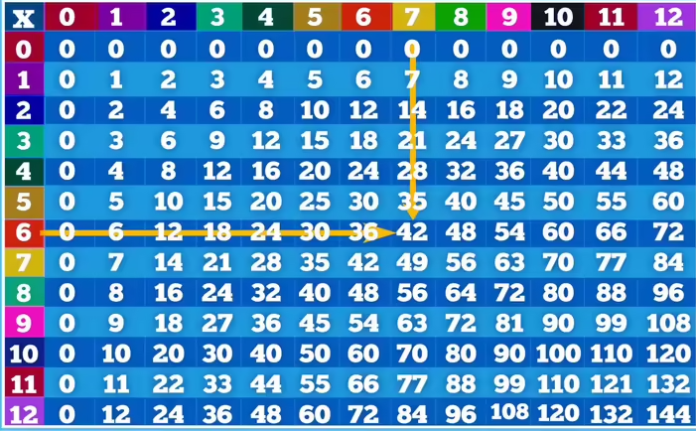An increase table is a rundown of products of a number. We can get the increase table by duplicating the given number with entire numbers. Increase is one of the fundamental numerical activities which is instructed to understudies at an early age. A basic way to deal with showing understudies the idea of duplication is through an increase table diagram.
Times tables can be very useful in doing essential math estimations. These work as building blocks for doing higher maths like divisions, examples, and some more. Printable augmentation outlines and tables are given to assist you with learning times tables easily.
What is Augmentation Outline?
An increase outline is a table that shows the result of two numbers. Generally, one bunch of numbers is composed on the left segment and one more set is composed on the top-most column. Having a duplication outline saves a lot of significant investment in doing computations.
Augmentation Outline 1 to 10
Times table diagram 1 to 10 comprises of the numbers composed from 1 to 10 on the top-most line of the lattice as well as on the furthest left section of the framework. For any remaining lines and sections, every one of the containers addresses numbers as the result of numbers, one from the top-most column and the other from the left segment. The increase graph is given beneath.
Printable Increase Diagram
A huge square should be isolated into 20 sections and 20 columns. The heading should be filled from left to right and start to finish from 1 to 20. In each square, duplicate the quantity of the line with the quantity of the segment. This duplication outline ought to be set some place where you will see it everyday. Make it an everyday practice to go through this duplication table outline day to day.
Increase Tables from 1 to 20
Increase tables are building blocks for multi-digit computations and tackling issues in view of parts, rates, and figuring. These times tables from 1 to 20 assistance a youngster in doing mental number-crunching and furthermore empowers the kid to handle more perplexing estimations handily.
Definition: An increase table is a rundown of products of a specific number. It is an instrument used to figure out how to duplicate two numbers. Multiple times table assists us with computing answers rapidly and without any problem.
Significance of Duplication Tables for Understudies
Duplication tables, otherwise called times tables, are the fundamental structure blocks for math computations. The memory of a kid is considerably more remarkable than a grown-up. The things which we learn at an early age firmly affect the cerebrum and they are held deep rooted.
The times tables can be critical as:
Duplication tables support the numerical learning of an understudy.
Provides them with a solid understand of the realities related with duplication.
Makes it more straightforward for understudies to figure out issues with science.
Understudies who have areas of strength for an of times tables, will generally be more confident while learning new number related ideas.
Tips to Remember Duplication Tables
Understudies ordinarily battle to retain duplication tables. Here we have recorded down a couple of successful tips to help understudies in remembering these times tables.
Practice ‘skip-counting’
Present the duplication table all together
Practice by composing
Apply augmentation to reality
Recognize designs
Practice Skip Counting: Begin with a number and afterward continue to add that equivalent number. For example, assuming you start by 3, continue to add 3 each chance to count. So you would agree that 3, 6, 9, 12…
Recount the Duplication Table all together: For example, you would agree “twice 1 is 2, 2 times 2 is 4, 2 times 3 is 6, etc. Make it a training to recount this table once day to day until you ace the design that it follows.
Practice Invert Table Recitation: Figure out how to say the augmentation table in reverse. Begin from the lower part of the section. For example, begin with “twice 20 is 40, 2 times 19 is 38, etc.
Practice by Composing: Assuming you are confronting trouble retaining the increase table, you generally have the choice of composing and learning. Make it a day to day everyday practice to compose the duplication tables and afterward discuss them once.
Apply Duplication to Reality: Attempt to comprehend augmentation tables utilizing genuine models. You can likewise have a go at rehearsing duplication during different occurrences, if conceivable. For instance, duplicating the cost of one item by the quantity of items or increasing the sum by the quantity of notes in a group.
Recognize Examples: Each increase table has its own example. Distinguishing this pattern is vital. It will assist you with remembering these times tables quicker.
Duplication Tables Addressed Models
Model 1: Sam labors for 5 hours every day and is paid $8 each hour. What amount does Sam procure in a day?
Arrangement: Since Sam labors for 5 hours and is paid $8 each hour. In this way, by utilizing duplication tables the aggregate sum that he acquires is multiple times 8.
∴ Sam procures $40.
Model 2: John has 6 cupcakes. He shares them similarly with his 3 companions. What number of cupcakes does every companion get?
Arrangement: This is a genuine issue including division realities related with duplication tables. Here, we really want to check the times table of 3 and search for the step where we get 6 as the item.
Along these lines, 3 × 2 = 6, for example 6 ÷ 3 = 2
∴ Every companion gets 2 cupcakes.
































